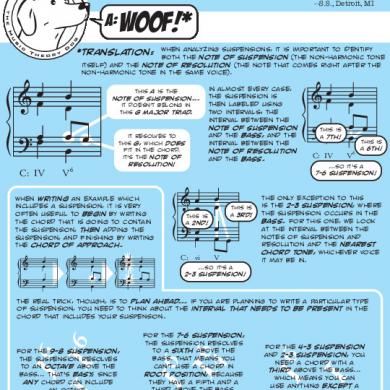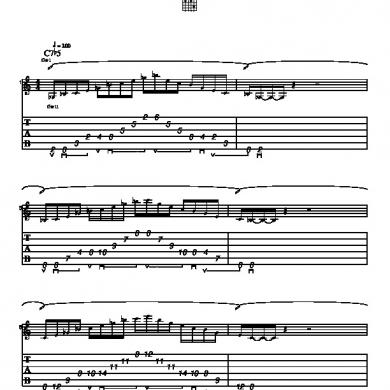V V Iii: We’ve Already Mentioned A Few Chords That Were Specific To The Romantic Era
This document was uploaded by user and they confirmed that they have the permission to share it. If you are author or own the copyright of this book, please report to us by using this DMCA report form. Report DMCA
Overview
Download & View V V Iii: We’ve Already Mentioned A Few Chords That Were Specific To The Romantic Era as PDF for free.
More details
- Words: 399
- Pages: 1
Loading documents preview...
baroque
renaissance
classical
V
we’ve already mentioned a few chords that were specific to the romantic era: dominant eleventh and 13 thirteenth chords, the “flat three” borrowed chord, and secondary subdominants.
V
bIII
romantic
early 20th century
contemporary
however, the music of the romantic era employed some interesting techniques that set it apart from the baroque and classical eras...
the music of the baroque, classical and romantic eras share a consistent use of harmony and counterpoint, enough to cause theorists and historians to group them together as the “Common Practice Period.”
11
1900
1800
1700
1500
1600
Romantic Era Techniques
2000
music theory for musicians and normal people by toby w. rush
ii° IV
...and foreshadow some of the big changes coming in the twentieth century!
ii° V iv IV
& # ˙˙
n ˙˙
? b˙ b˙
another technique that is unique to the romantic era is the resolution of an augmented sixth chord to a dominant seventh chord rather than a dominant triad, causing the interval of the augmented sixth to resolve obliquely instead of moving outward to the octave.
˙˙
V7
Ger.6
finally, romantic era composers would sometimes use a particular type of chord progression that had the effect of suspending tonality for a portion of the piece. By temporarily removing the feeling of being in a certain key, the composer could easily modulate to a distant key! if you think of tonality like being in a room...
this technique is called third relations because it involves moving by root movements of a major or minor third without respect to key signature.
... t ar hird of e l r f ike ela in the tur tion t fo he gra ning s r r v a oo ity bit m ...
for example...
œœœ
œœœ
IV
V
here, we’re in F major...
& b œœœ F: I
œœœ
I
...which obscures any sense of key we had...
& b # # # ˙˙˙
F #M
b b ˙˙˙
E bM
# ˙˙˙
DM
...here, we’re just moving down by thirds...
b n ˙˙˙
Bb M
n œœœ # # œœœ # œ # # n œœ B: I
IV
V
*whump*
œœ œ
...and then turning the gravity back on... but in a different direction!
I
and then we land in b major!
licensed under a creative commons BY-NC-ND license - visit tobyrush.com for more
renaissance
classical
V
we’ve already mentioned a few chords that were specific to the romantic era: dominant eleventh and 13 thirteenth chords, the “flat three” borrowed chord, and secondary subdominants.
V
bIII
romantic
early 20th century
contemporary
however, the music of the romantic era employed some interesting techniques that set it apart from the baroque and classical eras...
the music of the baroque, classical and romantic eras share a consistent use of harmony and counterpoint, enough to cause theorists and historians to group them together as the “Common Practice Period.”
11
1900
1800
1700
1500
1600
Romantic Era Techniques
2000
music theory for musicians and normal people by toby w. rush
ii° IV
...and foreshadow some of the big changes coming in the twentieth century!
ii° V iv IV
& # ˙˙
n ˙˙
? b˙ b˙
another technique that is unique to the romantic era is the resolution of an augmented sixth chord to a dominant seventh chord rather than a dominant triad, causing the interval of the augmented sixth to resolve obliquely instead of moving outward to the octave.
˙˙
V7
Ger.6
finally, romantic era composers would sometimes use a particular type of chord progression that had the effect of suspending tonality for a portion of the piece. By temporarily removing the feeling of being in a certain key, the composer could easily modulate to a distant key! if you think of tonality like being in a room...
this technique is called third relations because it involves moving by root movements of a major or minor third without respect to key signature.
... t ar hird of e l r f ike ela in the tur tion t fo he gra ning s r r v a oo ity bit m ...
for example...
œœœ
œœœ
IV
V
here, we’re in F major...
& b œœœ F: I
œœœ
I
...which obscures any sense of key we had...
& b # # # ˙˙˙
F #M
b b ˙˙˙
E bM
# ˙˙˙
DM
...here, we’re just moving down by thirds...
b n ˙˙˙
Bb M
n œœœ # # œœœ # œ # # n œœ B: I
IV
V
*whump*
œœ œ
...and then turning the gravity back on... but in a different direction!
I
and then we land in b major!
licensed under a creative commons BY-NC-ND license - visit tobyrush.com for more
Related Documents

Roy Iii V. Herbosa
February 2021 0
V V V V: V V V V
March 2021 0
N= C V V
January 2021 2
Baremos-a Wisc-v
January 2021 2
Plan Clasa A V A
January 2021 1More Documents from "AndreeaBlaj"

Woof!*: Doing Stuff The Sparky Way Is Always Fun!
January 2021 1




